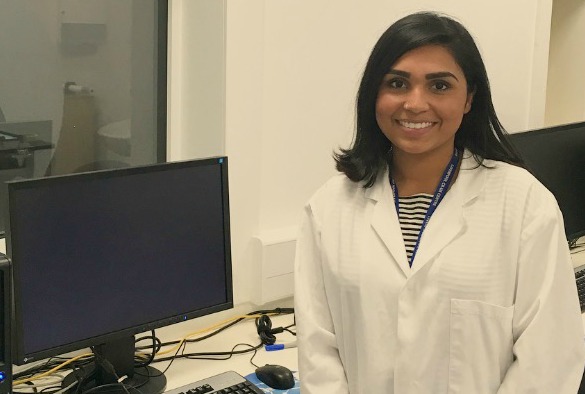
Abigail Chahil is a PhD student at the University’s Department of Clinical Molecular Pharmacology based in the MRC Centre for Drug Safety Science.
“Medicine has come a long way in its diagnostic testing and treatment for diseases. From biomarkers to biopsies, we continue to advance methods used for patient care. In light of this situation, imaging has become a major frontier in science in the twenty first century.
“We have come a long way in research with now having the benefits of non-invasive methods for screening whereby we can visualise and analyse the degree of injury without performing biopsies which can be a rather daunting procedure for the patient.
Why the liver?
“I may be slightly biased but I am exceptionally interest in the liver as I believe it is one of the most important functioning organs in the human body. As one of the largest and most resilient organs, the liver is highly under-appreciated and can still be susceptible to metabolic, toxic, microbial, circulatory and cancerous insults.
“The majority of drugs we ingest are processed through the liver and sometimes, due to enzyme breakdown, metabolisms and even genetics, these drugs can cause severe side effects leading to liver injury. To date, more than 900 drugs, toxins and herbs have been reported to cause liver injury, with the most common hospital admissions being paracetamol overdose. Just in the UK alone, hospital presentation of paracetamol overdose range up to 90,000 admissions yearly with an estimate cost impact of £8.3 million annually and cost per life saved averaging at £17.4 million.
“Furthermore, drug induced liver injury is a major reason for drug withdrawal from markets. This has a major impact on the pharmaceutical industry, as it affects the years of research and investment focused into developing a new drug, not forgetting all that time gone to waste. Therefore as pharmacologists, we aim to focus our research essentially into elucidating the mechanisms involved with drug interactions and metabolisms, hoping to enhance new drugs being marketed and reduced the toxic side effects of the current ones.
Pre-clinical Imaging
“Our department has an invested interest in research based on liver injury and other adverse drug reactions. My PhD focuses on the Magnetic Resonance Imaging into Drug Induced Liver Injury whereby we aim to screen and dictate the mechanisms for novel therapeutics, primarily in paracetamol induced liver injury.
“My research is funded by the UK Medical Research Council, a major funding body to the Centre for Drug Safety Science and the Department of Molecular and Clinical Pharmacology.
“Throughout the course of my PhD, I have collaborated with the Pre-Clinical Imaging Centre where I have been fortunate enough to experiment with the university’s new MRI machine. This has enabled me to investigate the pathophysiology of liver injury and visualise the changes in the liver when there is a toxin present. With this added technology, we aim to fill in the gaps of our knowledge and build a better picture in understanding the complexities of this organ and the effects it has throughout our body when it is damaged. Additionally, it is interesting to recognise that the application of this imaging model could also lead to research into other diseases such as chronic liver diseases and liver cancer.
“Hence, by incorporating the scientific knowledge we presently have on the liver and the modern use of imaging, we aim to test more therapeutics at quicker pace which will clinically lead to faster patient treatment, not forgetting the potential for newer screening models for patients admitted with liver injury.”
